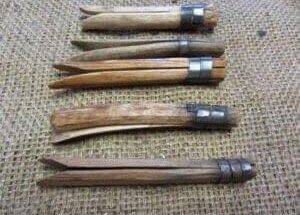This 2000s Teen Idol, Nominated for a Golden Globe, Lost His Memory & Went Bald Before 38 – Pics
The former star of “Malcolm in the Middle” experienced a striking transformation. Take a look at how he looks now and his surprising journey over the years, including his health challenges and leaving Hollywood.
This actor rose to fame as a child star, becoming a household name as the lead in “Malcolm in the Middle.” With multiple award nominations, including a Golden Globe nod, he seemed to have the world at his feet.

The actor on June 28, 2024, in Lebanon, Tennessee | Source: Getty Images
However, behind the scenes, the actor was dealing with a hostile work environment and health challenges. Dive into the telling photographs that capture his astonishing transformation through the recent years.

The actor on February 18, 2023, in Daytona Beach, Florida | Source: Getty Images
2020
In January 2020, the actor took to X, formerly known as Twitter, and shared, “In 2002 I was nominated for a Golden Globe. In 2020, I’m just sitting here staring in the mirror at my balding head.”

The actor is pictured with a bald head, as seen in a video dated March 24, 2024 | Source: TikTok/imacelebrityau
“Life is unfaiiiiiiiiiiiiir,” one person commented in response to the actor’s post. Another typed, “Life is unfairrrr…” A third person shared the same sentiment, writing, “Life is unfair.”

The actor is seen on September 22, 2020, in Los Angeles, California | Source: Getty Images
However, things took a more positive turn, as a month later, the actor tied the knot after proposing in November 2018. “I always thought it was such a cliché for people to claim their wedding day as the best day of their life,” he said.
“Like maybe it was something they had to say. No, my wedding day was literally the best day of my life!” the actor continued.
“My greatest accomplishment was convincing her to spend her life with me and I love her more now than I ever have. My love just grows more and more,” the star later shared in a heartfelt Facebook post.
2021
In March 2021, the “Stay Alive” alum and his wife, Paige Price, welcomed their first child, Mauz. The actor took to social media to open up about fatherhood, revealing his son’s impact on his life and how much he was in love with his little bundle of joy.
Towards the end of 2021, the actor shared details about his memory loss and revealed that he pondered why his memory was so bad and often visited doctors.
The “Agent Cody Banks” alum revealed that he couldn’t distinguish if his memories were dreams or if they really did happen. He added that perhaps he did so much in his youth that it made sense that he could not remember everything.

The actor, as seen on January 26, 2021 | Source: Getty Images
However, the actor acknowledged that the state of his memory loss was blown out of proportion due to the media. “This is the first time that I’ve actually gotten to clarify,” he stated. The award-winning star added that he did not actually have TIAs, as he was misdiagnosed. Instead, he suffered from intense migraines.

The actor is pictured on the set of a TV series on January 26, 2021 | Source: Getty Images
2022

The actor on the set of a TV series, on March 1, 2022 | Source: Getty Images

The actor pictured on a show on February 1, 2022 | Source: Getty Images
2023

The actor in Kansas City on May 6, 2023 | Source: Getty Images

The actor kissing his wife on February 18, 2023, in Daytona Beach, Florida | Source: Getty Images
2024
By 2024, at 38 and nearly two decades since the last episode of “Malcolm in the Middle” aired, the star remains a beloved figure even today. “I think some people forget how big of an actor Frankie was in the upcoming 2000s. He was everywhere at one point,” one social media user commented.

The actor with his wife and their son at the Steve Irwin Gala on May 11, 2024, in Las Vegas, Nevada | Source: Getty Images
Another wrote, “‘Malcolm in the Middle’ is one of the best shows ever. Malcolm, ‘King of the Hill,’ and ‘The Simpsons’ would all be on, in a row, on Sunday night, at one golden point in time. Frankie is a good dude.”

The actor at the NAStruck Craftsman Truck Series Rackley Roofing 200 on June 28, 2024, in Lebanon, Tennessee | Source: Getty Images
A third typed, “Frankie is the man. Grew up watching him and to see now, 15 years later, that he’s so humble and well put together is amazing. Didn’t get taken in by Hollywood or drugs and is living my dream life now with his family. Big kudos to him.”
The actor in question is none other than Frankie Muniz, once a beloved teen idol and now a race car driver. Scroll down to learn more about his rise to stardom, his transformation, his memory loss, and his decision to step away from the spotlight.
1998
The “Malcolm in the Middle” star was born in New Jersey and began acting when he was very young. However, he shot to fame for his iconic role in the sitcom, which ran for seven seasons.

The former “Malcolm in the Middle” star, circa 1998. | Source: Getty Images
The sitcom told the relatable story of a bright boy who lived in a dysfunctional family while dealing with the trials and tribulations of being a teenager and a middle child.

The actor posing for a studio portrait in Los Angeles, California, circa 1998. | Source: Getty Images

The star, circa 1998. | Source: Getty Images
2000

The actor at the 6th Annual Blockbuster Awards on May 9, 2000, in Los Angeles, California. | Source: Getty Images

The actor at the 2000 Teen Choice Awards on August 6, 2000, in Santa Monica, California. | Source: Getty Images

The young actor at the premiere of “The Lion King” the musical on October 19, 2000, in Los Angeles, California. | Source: Getty Images
2001

The actor at the “Malcolm in the Middle” album release party on February 1, 2001, in Studio City, California. | Source: Getty Images

Amanda Bynes and the star at the world premiere of “Josie and the Pussycats” on April 9, 2001, in Hollywood, California. | Source: Getty Images

The actor at the 14th Annual Kids’ Choice Awards on April 21, 2001, in Santa Monica, California. | Source: Getty Images
2002
Frankie’s performance as the highly intelligent yet often frustrated Malcolm earned him widespread acclaim. His comedic timing and ability to capture the complexities of a young genius navigating a chaotic family life made him a standout on the show.

Hilary Duff and the star at E! Online’s “Sizzlin’16” party on January 30, 2002, in Los Angeles, California. | Source: Getty Images
This not only contributed to the series’ success but also earned him award nominations. Frankie was nominated for the Golden Globe Best Performance by an Actor in a Television Series — Musical or Comedy category in 2001 and 2002.

The actor at Nickelodeon’s 15th Annual Kids’ Choice Awards on April 20, 2002, in Santa Monica, California. | Source: Getty Images

The star and Michelle Trachtenburg at the 2002 Teen Choice Awards on August 4 in Los Angeles, California. | Source: Getty Images

The young actor participating in the 17th Annual Magic Johnson “A Midsummer Night’s Magic” celebrity basketball game on August 11, 2002, in Hollywood, California. | Source: Getty Images

Tori Amos and the actor at the VH1 Big in 2002 Awards on December 4 in Los Angeles, California. | Source: Getty Images
2003

The actor at the world premiere of “Agent Cody Banks” on March 8, 2003, in Westwood, California. | Source: Getty Images

The star at Nickelodeon’s 16th Annual Kids’ Choice Awards on April 12, 2003, in Santa Monica, California. | Source: Getty Images
2004

The actor and his date at the premiere of “Chasing Liberty” on January 7, 2004, in Hollywood, California. | Source: Getty Images

The actor on MTV’s “Total Request Live” on March 11, 2004, in New York. | Source: Getty Images
2006
After “Malcolm in the Middle” ended in 2006, Frankie began racing cars professionally for several years. He then set his sights on music and played drums in two different rock bands. Years later, he managed one of the bands in his spare time but still hoped to return to acting.

Jamie Gandy and Frankie Muniz at a party for the launch of Converse by John Varvatos on March 23, 2006, in New York. | Source: Getty Images

Frankie Muniz at the 30th Anniversary Toyota Pro/Celebrity Race event on April 7, 2006, in Long Beach, California. | Source: Getty Images
2007
Frankie later opened up about why he was absent from two entire episodes despite being the show’s main character. The actor revealed that he walked off the set during those episodes due to escalating tensions.
He explained that the atmosphere on set had become toxic because the behavior of certain individuals had gone out of control, creating a sense of fear among the cast and crew.

Frankie Muniz and Misty Orman at the Halloween Party for 1690 Swimwear on October 20, 2007, in Los Angeles, California. | Source: Getty Images
According to the actor, people were too afraid to confront these individuals when they were controlling, rude, or disrespectful, making it feel like everyone was walking on eggshells. “I was so mortified by seeing people afraid to stand up for themselves, I was like: ‘Say something,'” he remarked.
Frankie said he did not mind the possibility of being removed from the show, as standing up felt worth it, especially given his role as the show’s lead character.

Frankie Muniz at the 1690 Swimwear launch party on April 1, 2007, in Los Angeles, California. | Source: Getty Images
2008
It was later reported that Frankie was earning approximately $150,000 per episode, and this amount did not take into account inflation. In no time, he was dubbed “Hollywood’s most bankable teen.”
During an interview, the actor revealed that while he enjoyed his fortune as a young star, he also made wise financial decisions like investing in land property that worked in his favor over time.

Frankie Muniz at the 34th Toyota Grand Prix of Long Beach 32nd Annual Pro/Celebrity Race on April 20, 2008, in California. | Source: Getty Images
2009
Thanks to “Malcolm in the Middle,” Frankie was a highly sought-after actor. However, he chose to focus on professional racing. This step back from Hollywood allowed the actor to stop and smell the roses, something he had not done much before. “I’m so much of a happier person, having stepped away,” he added.

Elycia Turnbow and Frankie Muniz at the premiere of “Star Trek” on April 30, 2009, in Hollywood, California. | Source: Getty Images
2010

Frankie Muniz of You Hang Up performing at the Universal CityWalk Celebrity Band Saturday Concerts on August 14, 2010, in Universal City, California. | Source: Getty Images
2017
In 2017, Frankie participated in “Dancing With the Stars.” On the show, the “Miracle in Lane 2” actor disclosed that he had suffered from nine concussions over the years. The first time was when he was seven during a soccer game.
In a candid interview, the child star said he had been in and out of ERs and doctors’ offices after being diagnosed with transient ischemic attacks (or TIAs), otherwise known as mini-strokes.

Frankie Muniz and Witney Carson posing at the “Dancing with the Stars” season 25 event on October 23, 2017, in Los Angeles, California. | Source: Getty Images
Unfortunately, his health problems did not end there, as he also had severe memory loss. It was so bad that he reportedly did not remember the feeling of receiving his first Emmy nomination in 2001.
His search for answers was tedious, especially since he made healthy choices. “I’m 31, I’ve never sipped alcohol, I’ve never touched a drug or taken a drag of a cigarette. The only thing I’ve felt was stress,” the actor shared.

Frankie Muniz and Witney Carson performing on “Dancing with the Stars” season 25 on November 20, 2017. | Source: Getty Images
Throughout his journey from a beloved child star to a professional racer and now as a husband and father, Frankie Muniz has remained a beloved figure in the entertainment industry.
While he has undergone a significant physical change over the years, he is fondly remembered for his relatable role and acclaimed performance on “Malcolm in the Middle.”



